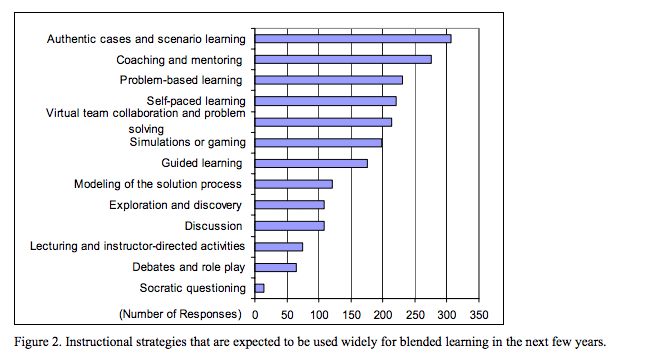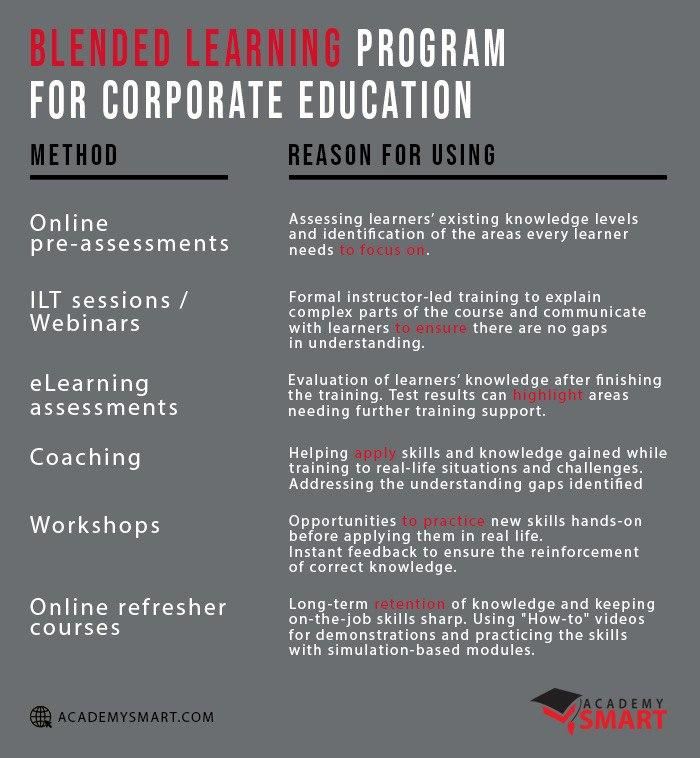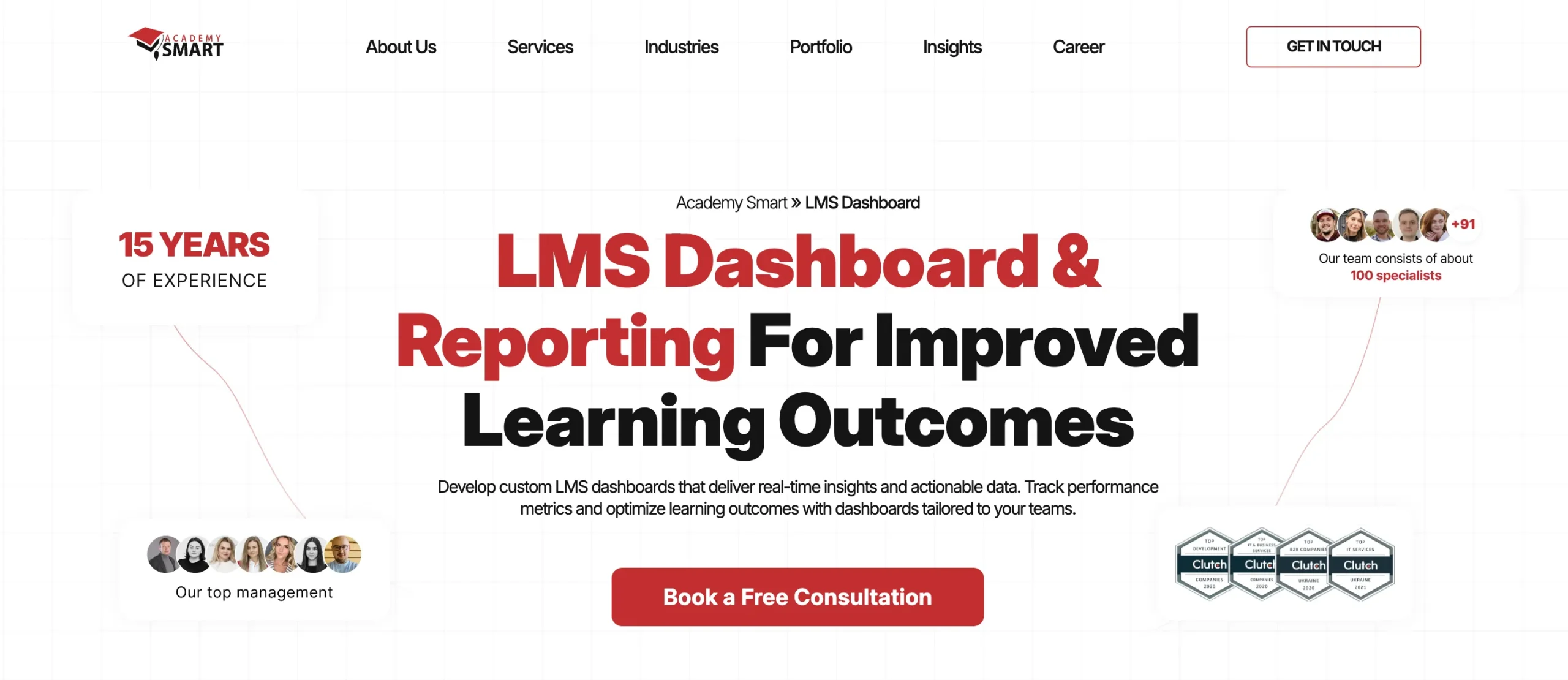Blended learning – what is it for?
Contents
Corporate education has to remain efficient to ensure its outcomes help the company remain competitive. Blended learning corporate training is one of the best approaches to dealing with this challenge. It is also called a flipped classroom model, where instructor-led sessions in the classroom (or via webinars) are combined with online learning. Read on to discover the types of blended learning, the benefits it provides and blended learning best practices.
1. What is a blended learning approach?
You’ve definitely heard of blended learning under one or many names — hybrid learning, blended education, flipped classroom, etc. At its core, blended learning is a combination of self-paced consumption of training materials online, and instructor-led sessions in the classroom or on webinars. This way, the learners can spend as much time as they need to grasp the information and practice new skills, while the classroom (webinar) time is dedicated to communication and collaboration to reinforce the learning outcomes.
2. Types of blended learning models
COVID-19 pandemic poses new challenges in all spheres of our lives, including corporate education, higher education, and K-12 education. How to deliver the training efficiently, track the learner’s progress independently, and analyze course performance consistently to ensure data-driven positive learning outcomes? Blended learning lends a hand, as the entirety of its types is well-suited to dealing with the new reality we live in.
Here is a brief overview of the most common types of blended learning to help you select the best fit for your organization, educational goals, and students.
- Face-to-face driver model blended learning. This type of blended learning fits best when you have a group of learners with mixed skill level and abilities, where some students perform better, while some fall behind. In this case, while the majority of training is still delivered face-to-face, additional online materials are provided to boost the performance of the least successful learners.
- Activity rotation model. Following this approach means the learners rotate their training activities during the course. These can include self-paced online knowledge consumption, one-on-one sessions with the instructor, communication and collaboration with peers in the group or studying independently, etc.. There are four main types of the activity rotation model:
– Station rotation, when the learners change the activities based on schedule or when prompted by the instructor. This is most often used in classroom-based training, but is still applicable for remote education through webinars
– Individual rotation, where the instructor or the algorithm creates individual schedules for every learner, based on their needs and abilities
– Lab rotation, when the main change is between a classroom and a computer lab for practical exercising
– Flipped classroom, which is so common that it became associated with the entire blended learning concept. The idea here is that learners consume knowledge on their own, through online course components, and classroom time is used to collaborate, analyze the results and reinforce the learning outcomes in discussions. - Self-blended learning — where motivated and self-organized learners are given the opportunity to take additional classes outside of the main course curriculum to gain deeper understanding of the subject
- Online driver model blended learning— where training delivery is strictly online and instructors simple facilitate the eLearning process through providing support on request
- Flex — the most powerful but resource-intensive form of blended learning, where self-paced online training is coupled with tutoring sessions. However, this is often the only way to help students at risk of failing and can lead to 300% increased achievement in under a year
- Online lab — where the courses are delivered online but only through specific workstations on campus or within a corporate training center.
Each of these types of blended learning has its use depending on your particular case.
3. Blended learning in the workplace
Blended learning replaces instructor-led training in corporate education due to allowing better training outcomes, less managerial overhead, less commuting expenses and so on.
These strategies are now trending in blended education:

Below we list 3 reasons why blended learning is the best choice for employee upskilling.
1.Decreased expenses, improved ROI
According to IBM research, nearly 40% of classroom training expenses go to commuting and lodging. Thus, removing the need to commute to get educated helps save time and money, which results in achieving productivity faster. Implementation of a Learning Management System (LMS) and blended learning helped Ernst and Young save 35% on training costs, while also increasing learning consistency and scalability across the board.
2.Improved feedback
Blended learning provides a multitude of tools to enable feedback. From tests and quizzes to course forums and face-to-face sessions, both the instructors and learners can seamlessly share feedback. This allows them to boost motivation, spot and address issues quickly, and constantly work on increasing the course efficiency.
3.Flexibility
Every learner has a preferred type of training consumption — visual, audial, kinesthetic, logical, numerical, etc. Blended education enables the instructors to create flexible course content that meets the needs and training preferences of your learners. In addition, the flexibility of course access over the web, be it from home laptops or through their tablets or smartphones, increases the engagement and performance of all students.
4. Blended learning in instruction
The digitalization of instruction brings flipped classroom methods to the forefront of attention. It has proven to provide better results than traditional teacher-led education, ensuring greater learner engagement and knowledge retainment. When the learners progress through the course on their own, the educator gets much more free time, contrary to when he has to present the course material to all the learners at once.
The free time can be spent helping laggards comprehend the material better. The educator can also use the feedback from the students to analyze the course content and adjust it. This feedback can be delivered in various forms and describe the quality or quantity of material.
Blended education systems commonly have automated data capture modules, allowing educators and parents to track the progress of every individual learner. Online tests are also scored automatically to provide instant feedback. These 2 benefits greatly reduce the time and effort needed for a teacher to provide feedback to every individual student.
Flipped classroom approach allows bright individuals or people with special needs to study at their own pace and master the topics outside of the main range of course subjects. This also enables the students to demonstrate self-development, independent learning and self-organization.
5. Blended learning best practices
Outside of the corporate education realm, blended learning is widely used in K-12 and higher education domains, but there are distinct differences regarding how it works in each.
In K-12 blended learning might take the form of tasks that should be completed online together with parents within a week. This way, the learners retain a degree of control over how, when and in which order they complete the assignments, while still following the schedule.
In addition, K-12 is different from higher education or corporate training, because kids are obviously less capable of self-organization and independent study. This means more time must be dedicated to teacher-led classes and less time to self-paced online studying.
Below is an example of a blended learning programme for corporate education

6. Benefits of blended training in corporate training
Every company might want to deliver multiple types of training: compliance training, onboarding of new employees or customers, training of partners, etc. Whatever the objective might be, blended learning provides multiple benefits to all parties involved:
Advantages for students
- With a blended approach to education, the students can consume knowledge whenever and wherever it suits them, as fast and as many times as they need to master it.
- Academic research shows the learners can achieve much better material comprehension with blended education, as compared to classroom-only training.
- Socialization features between peers and instructors provide a powerful social experience that boosts the engagement and performance.
Advantages for organizations
- Flipped classroom approach cuts on the commuting, accommodation and printout costs
- Organizations can use multiple eLearning engagement tools like gamification to improve learner engagement
- Blended training helps master the knowledge quicker and to a fuller degree, so the learners can apply new skills better, meaning faster and bigger return on investment
- In-detail personalized performance analytics is easily available
7. LMS importance for blended learning
Before delving into the benefits of using LMS to support blended learning in your corporate , higher or K-12 training strategy, let’s highlight underwater reefs to avoid:
- Not all LMSs are equally suited to delivering blended learning, including integrations with webinar software and other aspects. Select the one that does what you need.
- Build a blended learning strategy based on who your learners are, what they already know and what they need to learn. Continuously analyze the course content and improve it to ensure it remains relevant to your goals.
- Start slow. Transition from purely instructor-led training to blended learning should take time, especially in corporate training. Don’t expect to achieve results within a quarter, a year is a more likely term.
How to use LMS to offer best-of-breed training through blended learning?
- Define the goals of the training, and how to deliver its various components most competently.
- Evaluate the IT ecosystem in use. Can your learners access the LMS whenever and wherever they need?
- Check if the LMS you selected supports all the features your blended learning strategy requires: from secure online storage for training materials to pre-sesion notifications or post-training assessments and communication channels.
- Ensure both managerial buy-in and grassroot support for the blended learning initiative on the premise that it enables multiple benefits for the business.
- Develop, maintain and update a variety of training content — videos, guides, FAQs, tutorials, etc. Ensure 24/7 access to them, so your learners can use them ad-hoc.
- Gather feedback from your learners after each run of the blended learning course. Find out if they had any trouble using the LMS or understanding the course material — and seek the ways to rectify the situation.
Following these simple steps will help you develop an effective corporate training strategy that will help your organization benefit the most from adopting blended learning. Should you need help with enhancing your current LMS or developing a bespoke solution uniquely suited to your needs — contact us, we are always ready to help!
Book a free consultation

Reach out to start talking today!












